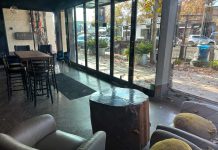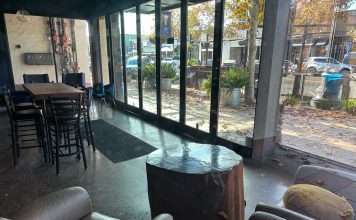By JAMES M. MOHS
Chief Photographer
GILROY
– The first crackle across the scanner jolted me from the
aftermath of a week of peaceful floating on a houseboat on a
Northern California lake.
By JAMES M. MOHS
Chief Photographer
GILROY – The first crackle across the scanner jolted me from the aftermath of a week of peaceful floating on a houseboat on a Northern California lake.
At 1:54 p.m. Sept. 23, the scanner in The Dispatch newsroom spoke:
“Battalion sixteen-thirteen, air attack four-six-zero, tanker eight-zero, one additional tanker, copter one-zero-six, engine sixteen-sixty-three, engine sixteen-eighty, engine sixteen-eighty-one, three units from CZU, transport dozer sixteen-forty, two crews on order – vegetation fire reported at Croy Road and Uvas and Little Uvas Roads, 13:54 hours,” the dispatcher said.
A call out for this many fire resources is not unusual due to dry conditions and high fire danger in early fall at the end of the dry season, but it was the location of the fire that caught my ear.
Knowing the rugged terrain and thick vegetation in the area of the call, I instantly sensed what could be the beginning of a natural disaster. This fire could quickly get out of control.
I grabbed my keys, and on the way out the door stuck my head in my editor’s office. He was planning Tuesday’s front page. I threw the possibility at him: This fire could get ugly, quickly.
“You better save me some space,” I said.
Heading north on Santa Teresa Boulevard toward the fire, I knew my concerns were warranted. Before I even passed First Street, I could see a large plume of smoke billowing into the sky from the Uvas Canyon area.
As my adrenaline began to flow, thoughts rushed through my mind.
Do I have my fire suit in the back of my new Jeep? How many batteries and camera memory cards do I have? What kind of access will I have in this rugged, mountainous terrain?
This type of fire chase is exactly why I bought a four-wheel-drive vehicle.
Monitoring the scanner as I drove, I continued to make my way to the fire. My car scanner continued to bark with orders of more resources. A CDF helicopter already nearing overhead of the fire was looking for access points for fire engines and crews. Dirt roads off Croy with access to the fire were poorly marked, making quick access difficult.
I tried to scribble notes with access information from the dispatcher as I drove.
Within minutes of the original call, four more engines, two more air tankers, three more helicopters and three more dozers were ordered. This fire was growing – and growing fast.
This was not just a routine roadside vegetation fire that happens in the summertime.
Driving into belly of the fire
After what seemed to be an endless drive with my heart pumping rapidly, I finally made it up Uvas Road to CroyRoad. I followed the first fire engines looking for the dirt road near 7900 Croy Road that would snake up the canyon to the fire’s origin. As we left the paved road and traveled onto a maze of dusty dirt roads, I put my Jeep in four-wheel drive and continued.
Less than a mile in, I stopped to get into my yellow Nomex wilderness fire jacket and pants. Without the proper protective gear, I knew my access would be restricted.
As quick as I could, I worked to get changed and organized. From working smaller fires over the years, I had learned to be prepared because, in this type of environment, things can change quickly and a split-second delay could cost me a great photo or cause me great harm.
As I frantically got organized, I watched the fire march its way down the ridge toward me.
And I was going into this monster, I thought.
I could hear that little voice in the back of my head asking, “What the hell are you doing? Are you nuts?”
“My job!,” I thought without hesitation.
“Remember your training and stay close to the firefighters,” I thought.
My first images, of what turned out to be nearly 1,000 covering Santa Clara County’s worst vegetation fire in 17 years, were of a structure near the top of the hill on the northern rim of the canyon. Flames leapt from behind the home twice as high as the roof. CDF helicopters and planes were dropping water and red fire retardant, desperately trying to save the structure.
The fire became so close I could hear its roar and smell its burning breath. This thing was hell bent on destruction, eating everything in its path.
As I fired off frames, the speed at which the angry blaze grew amazed me. I watched flames shoot more than 50 feet into the sky, covering a whole spectrum of color as the fire grew into an inferno. CDF aircraft were flying so low it sounded like the scene out of “Apocalypse Now” when the helicopters napalmed the coastline.
I could hear an arsenal of ammunition shooting off in the distance, triggered by the fire. This scene was beginning to feel a little uncomfortable.
“Am I more afraid of the fire or the stray bullets?” I thought. Now that’s a question you don’t want to ponder too often.
Behind me I heard the sound of what sounded like a tank with its tracks rumbling. Startled, I looked back and saw CDF bulldozer operator George Setty slowly driving dozer sixteen-forty up the road. I had talked to Setty on many routine fires during the summer.
He stopped briefly and I wished him luck, and without a moment’s hesitation he continued. I photographed the bulldozer with the fire raging in front of its path less than a mile away. The dancing inferno dwarfed the large dozer, making it look the size of a toy in contrast. I followed Setty for a while until he turned off the road to begin cutting a fire break.
I continued up the dirt road with my windows closed and the air conditioner on to filter the smoke.
Insatiable fire grows hungrier
Burning debris was falling from the sky as the fire gorged itself. Consuming so much vegetation at such a rapid rate, the fire created a giant convection column that was sucking burning debris at least 100 feet into the air and spreading it all directions, starting multiple spot fires at once.
In less than 45 minutes, the fire had moved from a routine news story to a potential disaster. And I was right in the middle of it as it raced through the canyon, taking on a life of its own as it grew from one to 10 to 30 acres and more.
I finally reached the top of the ridge around the eastern edge of the fire and located the fire trucks I followed in. Fire captains were working to establish a game plan on how to get a line around the fire, but the terrain made that job nearly impossible.
Circling CDF aircraft reported the directions of the fire’s rapid spread as it continued to have no problem jumping roads at a quick rate. With smaller fires, the roads provide a fire break, but not with this monster.
As radios and scanners continued to bark orders calling in additional engines, personnel and aircraft, the fire moved within 100 yards of my location with the incident commander. Over the scanner word came that the fire had surrounded a fire truck and crew. Copter one-zero-six hovered overhead looking to drop water. After a few tense minutes, and with the help of a couple of helicopter water drops, the crew escaped danger.
By this point, the fire had pretty much surrounded us.
“As long as the fire stays low, out of the tree canopy, we are safe,” I was told by a firefighter who could see the look of concern on my face. “Stay close to us, and don’t wonder off.”
Moving along the ridge to get behind the fire, I spent some time shooting down on the fire as residents raced to get out of the canyon. Helicopters and planes buzzed overhead at low levels on drops trying to slow the fire, but with another fire burning out of control near Los Angeles air resources were stretched thin, and the larger planes needed were not available.
I spent more than three hours working with firefighters and photographing their efforts as they shifted their game planes from putting out the fire to protecting homes, many of which that were surrounded by overgrown vegetation serving as ample fire fuel.
Having a hard time getting information back to the paper, I needed to get down the mountain. Cell phone coverage was very sporadic.
Making my way back down out of the fire proved to be much more difficult than I imagined. I quickly drove through areas that were still burning and the intense heat was a concern.
“Just keep moving, don’t stop and thank God for air conditioning,” I thought.
Without air conditioning – not just to cool the air, but to filter the smoky air – I never would have made it through.
Rounding a tight bend in the road, I came within feet of a fast moving wall of fire. Before backing up because of the intensity of the fire, I shot one image of the fire racing across the road through my windshield. That photo became the lead front page photo in the following day’s Dispatch.
I backed up quickly and waited a few tense minutes in an area the fire had already scorched.
Continuing down the road through an eerie quiet of crackling timber and burning vegetation, I was in awe of how fast the fire was able to consume so much. The area I photographed only a few hours before had been changed to nothing but a gray, black and smoky wasteland. A partially melted For Sale sign marked the spot of a former home like a headstone in a graveyard of burnt homes full of memories.
Back to the paper, smelling like smoke and dirty with ash, I edited more than 100 images down to about 15 and filed them for the next day’s edition.
Late Monday night as I watched the fire illuminate the sky west of Morgan Hill from my porch in San Martin, I realized this was just the beginning of what proved to be a very long, physically and mentally tiring, unforgettable week.
Following the day’s events and rush of adrenaline, little sleep came to me that night. I knew that it was important (and my job) to get back on the mountain as early as possible Tuesday morning.
Silence marks a new day
At the crack of dawn, I worked past lines on fire engines, bulldozers and water tenders that have arrived during the evening and were awaiting their assignments. Passing police barricades holding back tearfully worried residents, I headed back up Croy Road into the fire.
I made my way up the dirt road I had followed the previous day. As I looked to the east, I saw what turned out to be one of my most memorable images of the fire. Framed around leafless and charred manzanita branches sticking up from the gray ash mountainside, a yellow circle
began to rise through the smoke. No this horrible fire was not a dream – another day had begun.
Due to evacuations, there were not many people besides fire crews to photograph. Ironically, a quaint, peacefulness fell on the area, but I knew reality would soon set in.
Driving around dirt roads and listening for activity of handcrews cutting fire lines and clearing brush away from homes to make them less susceptible to fire, I came across Steve and Yvonne Slusser.
Steve, covered in dirt and silt, held his wife who had a look of relieved panic in her eyes. The two had spent the night trying to defend their home from flames. No firefighters knew they were even there. Only an hour before had Yvonne’s screams brought relief from firefighters across the canyon in the knick of time as fire danced up the walls of their home.
The look of relief on their faces after a night of terror made a photograph that needed no caption.
I gave them a gallon of water from my emergency supplies, and they shared the water as they watched fire crews save their home.
Residents return to ravaged homes
Tuesday and Wednesday held many similar stories as I roamed the hills covering the fire. Although many residents were evacuated, many others stayed to the last minute – praying the fire would not engulf their homes. I drove miles of fire roads photographing the destruction as this fire tore through.
In the early hours of Thursday morning, I met with Croy Road resident Dave Henry and Dispatch reporter Jon Jeisel. We were going to accompany Henry through the barricades to see his home. Or anything left of it.
Henry had no idea the extent of damage. After making our way past a number of burnt out plots, we arrived at his land. I could not believe how calmly he surveyed the damage.
Nothing was left, except his Harley Davidson motorcycle – which sat like a trophy under a small charred tree amongst a mix a charred, gray and twisted metal. We walked around with Henry as he described what used to be his mountain paradise. Fortunately for Henry, his home was insured, and he had proper permits. He, unlike many others, would be able to rebuild.
In my 10 years as a photojournalist, this was the biggest news event I had covered, and by the end of Thursday I was done. The long days and disastrous nature of the event slowly took their toll.
Would I ever be able to get this smell cleaned off me and my Nomex yellow fire suit that I had practically lived in for the past four days?
Fire under control
Luckily by Friday, with the help of moist, foggy nights on the western flank, fire crews had begun to gain control. The fire had spread in so many fingers it was hard to pinpoint activity. It was now mostly many little hot spots – little areas of fire within the main burn area.
Saturday morning I took a CDF helicopter flight over the area to photograph the origin of the fire and the vast destruction. Only from the air could you get a true perspective on the 3,127 acres charred by the fire. It did not run in any set direction. It just fingered out all over the place with a life of its own.
Later in the day I was back on the ground working my way back up Redwood Retreat Road. Plumes of smoke had begun to rise again, but, luckily, these fires were controlled back burns in front of the main fire line to establish a solid fire break.
Good. The steady attack of more than 1,000 firefighters and air crews and bulldozers had the fire in hand. Only smoldering embers and the memories of how quickly a fire can strike remained in my mind as thousands of other South County residents were in some way affected by the fire.
James M. Mohs is the chief photogragher at The Dispatch.















